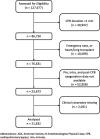Hyperoxemia During Cardiac Surgery Is Associated With Postoperative Pulmonary Complications
- PMID: 36875558
- PMCID: PMC9984162
- DOI: 10.1097/CCE.0000000000000878
Hyperoxemia During Cardiac Surgery Is Associated With Postoperative Pulmonary Complications
Abstract
The use of hyperoxemia during cardiac surgery remains controversial. We hypothesized that intraoperative hyperoxemia during cardiac surgery is associated with an increased risk of postoperative pulmonary complications.
Design: Retrospective cohort study.
Setting: We analyzed intraoperative data from five hospitals within the Multicenter Perioperative Outcomes Group between January 1, 2014, and December 31, 2019. We assessed intraoperative oxygenation of adult patients undergoing cardiac surgery with cardiopulmonary bypass (CPB). Hyperoxemia pre and post CPB was quantified as the area under the curve (AUC) of Fio2 above 0.21 in minutes when the corresponding peripheral oxygen saturation was greater than 92% measured by pulse oximetry. We quantified hyperoxemia during CPB as the AUC of Pao2 greater than 200 mm Hg measured by arterial blood gas. We analyzed the association of hyperoxemia during all phases of cardiac surgery with the frequency of postoperative pulmonary complications within 30 days, including acute respiratory insufficiency or failure, acute respiratory distress syndrome, need for reintubation, and pneumonia.
Patients: Twenty-one thousand six hundred thirty-two cardiac surgical patients.
Interventions: None.
Measurements and main results: During 21,632 distinct cardiac surgery cases, 96.4% of patients spent at least 1 minute in hyperoxemia (99.1% pre-CPB, 98.5% intra-CPB, and 96.4% post-CPB). Increasing exposure to hyperoxemia was associated with an increased risk of postoperative pulmonary complications throughout three distinct surgical periods. During CPB, increasing exposure to hyperoxemia was associated with an increased odds of developing postoperative pulmonary complications (p < 0.001) in a linear manner. Hyperoxemia before CPB (p < 0.001) and after CPB (p = 0.02) were associated with increased odds of developing postoperative pulmonary complications in a U-shaped relationship.
Conclusions: Hyperoxemia occurs almost universally during cardiac surgery. Exposure to hyperoxemia assessed continuously as an AUC during the intraoperative period, but particularly during CPB, was associated with an increased incidence of postoperative pulmonary complications.
Keywords: cardiac surgery; hyperoxemia; postoperative pulmonary complications; supplemental oxygen.
Copyright © 2023 The Authors. Published by Wolters Kluwer Health, Inc. on behalf of the Society of Critical Care Medicine.
Conflict of interest statement
Dr. Douin received research grant funding from the National Institutes of Health (NIH)/National Institute of General Medical Sciences (NIGMS) T32GM135169. Dr. Clendenen received research grant funding from the NIH/NHLBI K23HL151882 (principal investigator: to Dr. Clendenen). The remaining authors have disclosed that they do not have any potential conflicts of interest.
Figures




Similar articles
-
Arterial Hyperoxemia During Cardiopulmonary Bypass Was Not Associated With Worse Postoperative Pulmonary Function: A Retrospective Cohort Study.Anesth Analg. 2024 May 1;138(5):1003-1010. doi: 10.1213/ANE.0000000000006627. Epub 2023 Sep 21. Anesth Analg. 2024. PMID: 37733624 Free PMC article.
-
Postcardiopulmonary bypass hypoxemia: a prospective study on incidence, risk factors, and clinical significance.J Cardiothorac Vasc Anesth. 2000 Oct;14(5):506-13. doi: 10.1053/jcan.2000.9488. J Cardiothorac Vasc Anesth. 2000. PMID: 11052429
-
A Multicenter, Randomized, Controlled Phase IIb Trial of Avoidance of Hyperoxemia during Cardiopulmonary Bypass.Anesthesiology. 2016 Sep;125(3):465-73. doi: 10.1097/ALN.0000000000001226. Anesthesiology. 2016. PMID: 27404222 Clinical Trial.
-
Cardiopulmonary Bypass in Non-Cardiac Surgery.Heart Lung Circ. 2019 Jun;28(6):959-969. doi: 10.1016/j.hlc.2018.04.284. Epub 2018 Apr 19. Heart Lung Circ. 2019. PMID: 29753653 Review.
-
Unrecognized Pulmonary Hypertension in Non-Cardiac Surgical Patients: At-Risk Populations, Preoperative Evaluation, Intraoperative Management and Postoperative Complications.J Cardiovasc Dev Dis. 2023 Sep 19;10(9):403. doi: 10.3390/jcdd10090403. J Cardiovasc Dev Dis. 2023. PMID: 37754832 Free PMC article. Review.
Cited by
-
Effect of one-lung ventilation in children undergoing lateral thoracotomy cardiac surgery with cardiopulmonary bypass on postoperative atelectasis and postoperative pulmonary complications.BMC Pediatr. 2025 Apr 2;25(1):268. doi: 10.1186/s12887-025-05600-0. BMC Pediatr. 2025. PMID: 40175952 Free PMC article. Clinical Trial.
References
-
- Heinrichs J, Lodewyks C, Neilson C, et al. : The impact of hyperoxia on outcomes after cardiac surgery: A systematic review and narrative synthesis. Can J Anaesth 2018; 65:923–935. Repercussions de l’hyperoxie sur les resultats apres une chirurgie cardiaque: revue systematique et synthese narrative - PubMed
-
- Ihnken KW, Schlensak C, Sarai K, et al. : Normoxic cardiopulmonary bypass reduces oxidative myocardial damage and nitric oxide during cardiac operations in the adult. J Thorac Cardiovasc Surg 1998; 116:327–334 - PubMed
-
- McGuinness SP, Parke RL, Drummond K, et al. ; SO-COOL Investigators: A multicenter, randomized, controlled phase IIb trial of avoidance of hyperoxemia during cardiopulmonary bypass. Anesthesiology 2016; 125:465–473 - PubMed
-
- Apostolakis E, Filos KS, Koletsis E, et al. : Lung dysfunction following cardiopulmonary bypass. J Card Surg 2010; 25:47–55 - PubMed
Grants and funding
LinkOut - more resources
Full Text Sources

